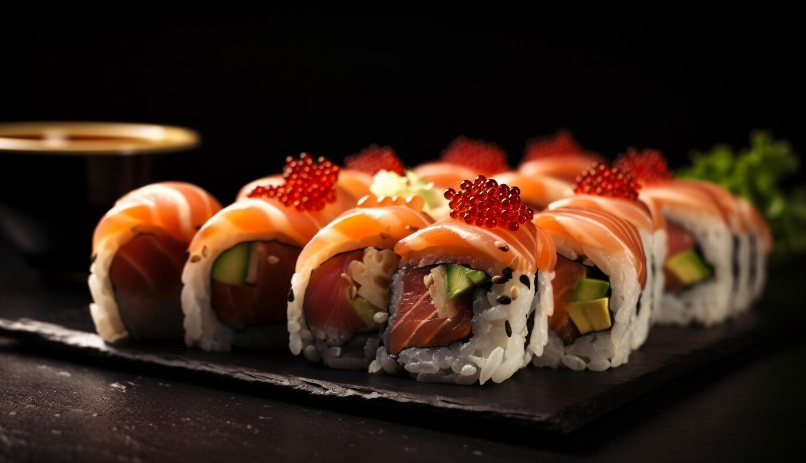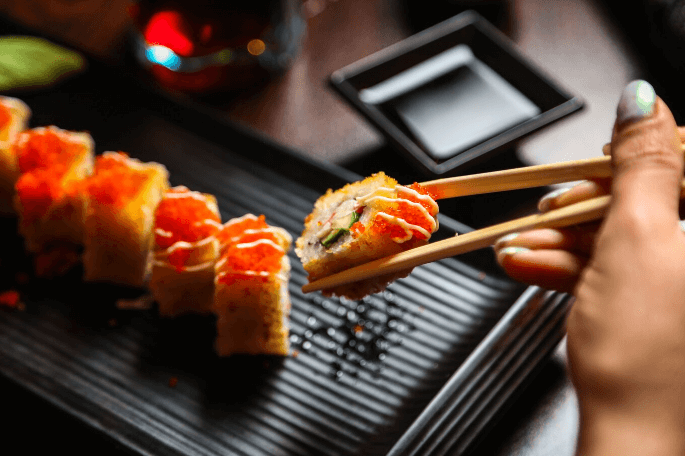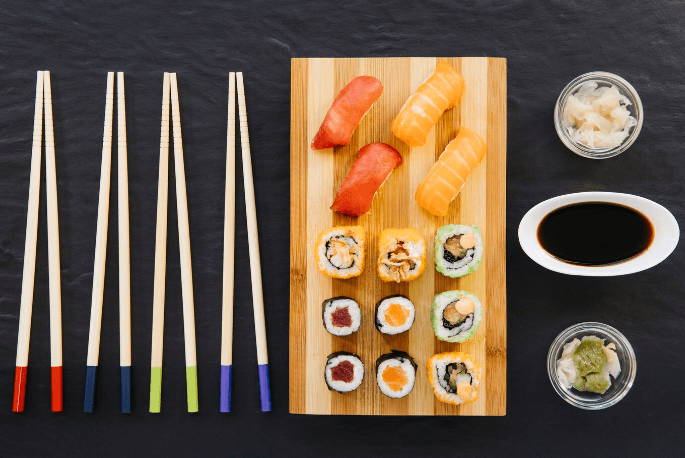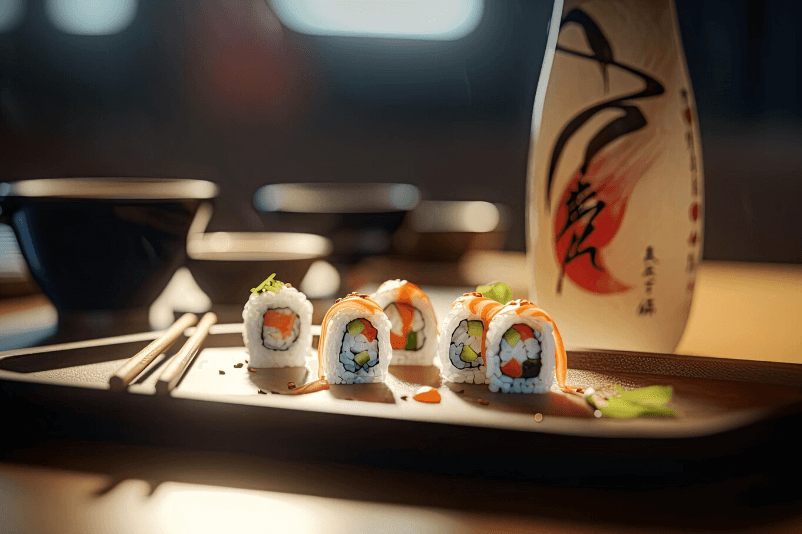What is Smelt Egg? A Sushi Egg Exploration

Indulge in a culinary exploration like no other and uncover the world of smelt egg, a seafood delight that is sure to tantalize your taste buds. Sushi connoisseurs from around the globe have long revered this tiny, translucent egg for its unique flavor and delicate texture.
Also known as masago, this sushi egg comes from the smelt fish species, which is widely found in the coastal waters of Japan. The eggs are carefully harvested and processed to preserve their freshness and essence. Served as a topping in sushi rolls or as a garnish, smelt egg adds a burst of umami flavor and a satisfying crunch to every bite.
Prepare to embark on a journey of taste and discovery as we delve deeper into the world of smelt egg. Delight in the subtle brininess and inherent sweetness of these tiny pearls, which are reminiscent of the ocean’s bounty. Whether you’re a sushi aficionado or a curious food lover, smelt egg is sure to captivate your senses and leave you craving for more.
The Origin of Smelt Egg
Sushi-inspired eggs have become a popular delicacy in many parts of the world, and one variant that stands out is the smelt egg. These small, brightly colored eggs are commonly used as a sushi topping, adding a burst of flavor and visual appeal to any sushi roll. But where do smelt eggs come from, and how did they become such a sought-after culinary delight?
The smelt egg, also known as masago, is sourced from the smelt fish, a small species that is found in the coastal waters of Japan and other parts of the world. The fish itself is not commonly consumed, but its eggs have become a staple in sushi-making due to their unique texture and taste.
Harvesting and Processing
Smelt eggs are typically harvested in the spring, when the fish gather in large schools to spawn. Fishermen use nets and traps to catch the smelt, ensuring that the eggs are carefully preserved. Once harvested, the eggs are taken to processing facilities, where they are carefully cleaned and sorted.
The processing of smelt eggs involves removing the egg sac from the fish, cleaning it thoroughly to remove any impurities, and then preserving it with salt or brine. This process helps to enhance the flavor and also extends the shelf life of the eggs.
Culinary Exploration
Smelt eggs were traditionally used in Japanese cuisine, particularly in sushi and sashimi. However, their popularity has spread to other cuisines around the world, with chefs and home cooks experimenting with these tiny, flavorful eggs in a variety of dishes.
Smelt eggs can be enjoyed on their own as a garnish or used as a topping for sushi, sashimi, and even salads. They add a crunchy texture and a burst of umami flavor, making them a favorite among sushi enthusiasts and chefs alike.
Overall, the origin of smelt eggs can be traced back to the coastal waters of Japan, where these small fish have been harvested for centuries. Today, they are a sought-after delicacy that adds a touch of elegance and flavor to any culinary creation.
History of Smelt Egg in Japanese Cuisine
Smelt egg, also known as tobiko, is a seafood delight that plays an important role in Japanese cuisine. The use of smelt egg as a sushi egg topping dates back centuries, and it has become a staple in traditional sushi rolls.
Smelt egg is made from the roe of the smelt fish, a small silver fish found in the Pacific and Atlantic oceans. The eggs are carefully harvested and processed to create the small, brightly colored orbs that are beloved in sushi dishes.
In the early days, smelt egg was primarily used as a garnish and added a pop of vibrant color to sushi rolls. However, as the popularity of sushi grew, so did the demand for smelt egg. Chefs started to experiment with different preparations and techniques, resulting in a variety of smelt egg flavors and textures.
Today, smelt egg is available in different flavors such as wasabi, yuzu, and mentaiko, providing sushi enthusiasts with a unique and diverse culinary experience. It is commonly used as a topping for sushi rolls, nigiri, and sashimi, adding a burst of flavor and visual appeal to the dish.
Smelt egg has become an integral part of Japanese cuisine, representing the creativity and innovation of sushi chefs. Its delicate taste, crunchy texture, and beautiful appearance make it a sought-after ingredient for sushi lovers around the world.
Next time you enjoy a sushi roll, take a moment to appreciate the history and artistry behind the smelt egg that graces your plate.
Why You Should Try Smelt Egg
Smelt eggs, also known as sushi eggs, are a seafood delight that should not be missed if you’re a fan of sushi or seafood in general. These tiny, translucent pearls are packed with flavor and offer a unique texture that adds depth to any dish.
What sets smelt eggs apart from other seafood delicacies is their size and taste. Each individual egg is smaller than a pea, making them perfect for garnishing dishes or adding a burst of flavor to your favorite sushi roll. Despite their small size, smelt eggs pack a punch when it comes to taste. They have a mild, slightly briny flavor that is reminiscent of the ocean.
Not only do smelt eggs bring a burst of flavor to your dish, but they also provide a delightful textural experience. When you bite into a sushi roll or a dish garnished with smelt eggs, you’ll be greeted with a gentle pop as the eggs release their savory juices. The delicate texture of smelt eggs adds an enticing contrast to the softness of other ingredients, creating a harmonious balance of flavors and textures.
Whether you’re a sushi aficionado or simply looking to try new and exciting ingredients, smelt eggs are a must-try. Their unique flavor and texture make them a fantastic addition to any seafood dish or sushi creation. Don’t miss out on the opportunity to experience the delight of smelt eggs!
Smelt Egg in Traditional Japanese Sushi
In the culinary exploration of Japanese cuisine, one cannot overlook the significance of the sushi egg. Particularly, the smelt egg, known as “masago” in Japanese, is a seafood delight that contributes to the rich flavors and textures of traditional sushi.
Smelt eggs are derived from the small, silvery fish known as smelt. These tiny eggs are carefully harvested and processed, creating a delicacy that adds a burst of briny flavor and a delightful pop to sushi rolls and various dishes.
The smelt egg’s vibrant orange color adds brightness and visual appeal, making sushi rolls even more enticing. It provides a subtle sweetness that complements the umami flavors of the raw fish or other toppings. Whether sprinkled on top of a sushi roll or mixed into a sauce, the smelt egg adds an extra layer of complexity to the overall taste profile of the dish.
| Key Characteristics of Smelt Egg | |
|---|---|
| Color: | Vibrant orange |
| Texture: | Small, delicate eggs with a slight pop when bitten into |
| Flavor: | Briny, subtly sweet |
Smelt eggs are most commonly used in sushi rolls, but they can also be found in other traditional Japanese dishes such as chirashi bowls and sashimi. These tiny eggs provide a unique textural element, enhancing the overall experience of each bite.
When enjoying sushi dishes that contain smelt egg, it is important to appreciate the craftsmanship and attention to detail that goes into each bite. The delicate balance of flavors and textures is what makes traditional Japanese sushi so special and distinct. So, the next time you indulge in a sushi roll, take a moment to savor the smelt egg, and let it transport you into the world of sushi-inspired eggs.
Unique Flavors of Smelt Egg
Embarking on a culinary exploration, one cannot miss out on the exquisite taste of smelt egg. This seafood delight is a delicacy that sushi enthusiasts adore. What sets smelt egg apart from other types of sushi-inspired eggs is its unique flavors that tantalize the taste buds.
When biting into smelt egg, you are met with a burst of flavors that are both savory and slightly sweet. The eggs have a delicate texture that adds a delightful crunch to every bite. The flavor profile of smelt egg can be described as subtle yet pronounced, making it a wonderful addition to any sushi dish.
Umami Delight
One of the standout characteristics of smelt egg is its umami flavor. Umami, often referred to as the “fifth taste,” is a savory taste that adds depth and richness to a dish. Smelt egg is packed with umami goodness, offering a truly satisfying culinary experience.
Nuances of the Sea
As a seafood delight, smelt egg carries the essence of the ocean within its tiny orbs. The flavors of the sea intertwine with the umami notes, creating a harmonious combination that seafood lovers crave. The natural saltiness of the smelt eggs enhances their seafood taste, transporting you to the sea with each bite.
Whether served as a topping on sushi rolls, mixed into sushi rice, or enjoyed on its own, smelt egg brings a burst of unique flavors to the table. Its subtle sweetness, umami richness, and nuances of the sea make it a sought-after ingredient in the world of sushi-inspired cuisine.
- Savory and slightly sweet flavor profile
- Delicate texture with a satisfying crunch
- Rich in umami goodness
- Carries the essence of the sea
- Enhances the taste of sushi dishes
How Smelt Egg is Harvested
Smelt eggs, also known as sushi eggs, are a seafood delight that add a burst of flavor to sushi dishes. These small, orange eggs are harvested from the smelt fish, a species found in seas and rivers around the world.
The process of harvesting smelt eggs is meticulous and requires great skill. It begins with catching the smelt fish during their peak spawning season. The fish are caught using specialized nets or traps, ensuring that they are handled carefully to prevent any damage to the eggs.
Once the smelt fish are caught, they are quickly taken to processing facilities where the eggs are carefully extracted. This delicate process involves gently massaging the fish’s abdomen to remove the eggs without rupturing them. The eggs are then carefully separated from any membranes, ensuring that they remain intact.
After the eggs are extracted, they are rinsed to remove any impurities and excess slime. This is a crucial step to ensure the highest quality of sushi eggs, as any impurities can affect the taste and texture of the final product.
Once rinsed, the eggs are lightly salted to enhance their flavor and preserve them. They are then packed into jars or containers, ready to be distributed to sushi restaurants and other culinary establishments around the world.
The process of harvesting smelt eggs requires precision, expertise, and attention to detail. The result is a culinary delicacy that adds a unique touch to sushi dishes and other seafood delights.
Smelt Egg in Modern Culinary Trends
Smelt egg, also known as sushi egg or seafood delight, has gained immense popularity in modern culinary trends. This delicate delicacy has become a staple in sushi-inspired dishes, captivating the taste buds of food enthusiasts with its unique flavor profile and a burst of umami.
The Rise of Smelt Egg
In recent years, smelt egg has emerged as a trendy ingredient in various cuisines around the world. Its small, vibrant orange eggs add a touch of elegance and sophistication to both traditional and contemporary dishes.
Its rich, briny taste, reminiscent of the ocean, brings a burst of flavor to any dish it is added to. Chefs and food connoisseurs appreciate its versatility, as it can be used as a topping, garnish or incorporated into various recipes.
Creative Uses of Smelt Egg
Smelt egg has found its way into a plethora of culinary creations. In sushi, it is often used as a topping for nigiri, maki, and sashimi, adding a pop of color and an extra layer of complexity to the dish.
Moreover, smelt egg can be used as a garnish for salads, soups, and seafood dishes, instantly enhancing their visual appeal. Its small size and bright hue make it a perfect addition to any dish, elevating the overall presentation.
Restaurants and chefs have also started experimenting with smelt egg in other dishes, such as pasta, rice bowls, and even desserts. This unexpected twist adds an element of surprise and delight to familiar flavors, showcasing the versatility of the ingredient.
Health Benefits of Smelt Egg
In addition to its culinary allure, smelt egg also offers various health benefits. It is rich in protein, omega-3 fatty acids, vitamins, and minerals. These nutrients promote overall health and well-being, supporting brain function, heart health, and immune system strength.
Its low-calorie content makes it a guilt-free addition to meals, allowing individuals to enjoy its flavors without compromising their dietary goals.
Overall, smelt egg has cemented its place in modern culinary trends. Its unique qualities, versatility, and health benefits make it a sought-after ingredient among chefs and food enthusiasts alike. Whether used as a topping, garnish, or incorporated into recipes, smelt egg adds a touch of elegance and a burst of flavor to any dish it graces.
Health Benefits of Smelt Egg
Smelt eggs, also known as sushi eggs, are small, delicate, and bursting with flavor. These tiny eggs are gathered from the roe of the smelt fish and are a popular delicacy in many cuisines around the world. Apart from their delicious taste, smelt eggs also offer various health benefits. Here are some of the reasons why including smelt eggs in your culinary exploration can be beneficial to your health:
1. Rich in Nutrients
Smelt eggs are packed with essential nutrients such as vitamins A, B, and D, as well as minerals like calcium, potassium, and magnesium. These nutrients play a vital role in maintaining the overall health of your body.
2. Excellent Source of Protein
Protein is an essential macronutrient that is needed for the growth and repair of cells, tissues, and muscles. Smelt eggs are a great source of protein, making them a valuable addition to any diet, especially for those following a vegetarian or vegan lifestyle.
In addition to these benefits, smelt eggs also contain omega-3 fatty acids, which are known for their anti-inflammatory properties. These fatty acids help reduce inflammation in the body, improve brain health, and support heart health.
Overall, smelt eggs are not only a delicacy in the world of sushi-inspired eggs but also a nutritious addition to your diet. So, the next time you come across smelt eggs, don’t miss the opportunity to indulge in their unique flavors and reap their health benefits!
Preparing and Serving Smelt Egg
As part of the culinary exploration into the world of sushi-inspired eggs, smelt egg has gained popularity for its unique texture and delicate flavor. Preparing and serving smelt egg requires a few simple steps to ensure the best results.
1. Sourcing Fresh Smelt Egg
The first step in preparing smelt egg is to source fresh eggs. Smelt egg can be found at specialty seafood markets or Japanese supermarkets. Look for eggs that appear shiny and have a vibrant orange color. Avoid eggs that have a dull or discolored appearance.
2. Cleaning and Marinating Smelt Egg
Before serving, it is important to clean the smelt eggs thoroughly. Place the eggs in a colander and rinse them under cold running water. Gently rub the eggs with your fingers to remove any impurities or excess salt.
After cleaning, marinate the smelt egg for added flavor. This can be done by mixing the eggs with a marinade of soy sauce, mirin, and a small amount of sugar. Allow the eggs to marinate for at least 30 minutes to absorb the flavors.
3. Serving Suggestions
Smelt egg can be enjoyed in a variety of ways:
- As a topping for sushi rolls or nigiri: Simply place a small amount of smelt egg on top of sushi rice or seafood.
- In a salad: Mix smelt egg with fresh greens, cucumber, and radish for a refreshing and colorful salad.
- As a garnish for seafood dishes: Sprinkle smelt egg on top of grilled fish or sashimi to add a burst of flavor and texture.
When serving smelt egg, it is important to handle the eggs gently to preserve their delicate texture. Use a spoon or chopsticks to carefully portion the eggs onto the desired dish.
By following these simple steps, you can elevate your sushi-inspired dishes with the delicate and delicious smelt egg. Enjoy the unique flavor and texture of this culinary gem!
Pairing Smelt Egg with Other Ingredients
When it comes to culinary exploration, the sushi egg offers a world of possibilities. Its unique flavor and texture make it a perfect ingredient to pair with other complementary flavors. Whether you are a fan of seafood or simply looking to add a touch of sophistication to your dishes, smelt egg can elevate any dish to new heights.
One of the most popular ways to enjoy smelt egg is in sushi rolls. The delicate and briny taste of the eggs pairs perfectly with fresh seafood like tuna or salmon. The combination of textures, with the creamy rice and crunchy vegetables, creates a well-balanced and flavorful bite.
If you’re feeling adventurous, you can also try pairing smelt egg with other seafood delights. The eggs’ mild flavor allows them to complement the rich and buttery taste of scallops or the tender sweetness of crab meat. Whether it’s in a salad, a stir-fry, or a sushi bowl, smelt egg adds a touch of elegance to any seafood dish.
For those who prefer vegetarian options, smelt egg can still be a delicious addition to your meals. Its umami-rich flavor can enhance the taste of grilled vegetables or roasted mushrooms. The pop of color and burst of flavor from the eggs can transform a simple salad into a gourmet experience.
To truly appreciate the delicate taste of smelt egg, it’s important to pair it with ingredients that will enhance its flavor, rather than overpower it. Experiment with different combinations and let your taste buds guide you on a culinary journey full of delightful surprises.
| Pairing Options | Recommended Dishes |
|---|---|
| Tuna and Smelt Egg | Sushi rolls, poke bowls |
| Salmon and Smelt Egg | Sushi rolls, sashimi |
| Scallops and Smelt Egg | Grilled scallops, seafood pasta |
| Crab Meat and Smelt Egg | Crab salad, California rolls |
| Grilled Vegetables and Smelt Egg | Vegetable skewers, roasted vegetable salad |
| Roasted Mushrooms and Smelt Egg | Mushroom risotto, creamy mushroom soup |
Exploring Different Types of Sushi-Inspired Eggs
Sushi is a culinary exploration that delights the taste buds with its unique flavors and textures. One of the key ingredients in many sushi dishes is the sushi egg, which adds a creamy and slightly sweet taste to the overall experience. These sushi-inspired eggs come in various types and are a staple in Japanese cuisine.
Ikura
One popular type of sushi egg is ikura, which is made from the roe of salmon. These bright orange eggs burst with a savory and slightly fishy flavor that complements the other ingredients in sushi rolls and nigiri. The texture of the ikura is slightly firm, giving a satisfying pop when you bite into it.
Tobiko
Tobiko is another type of sushi egg that is often used as a garnish or topping for sushi dishes. These small, colorful eggs are made from the roe of flying fish and have a unique crunchy texture. Tobiko comes in various colors, including red, orange, gold, and black, adding visual appeal to your sushi rolls.
Uni
If you’re looking for a delicacy in the sushi egg world, uni is the way to go. Uni is made from the roe of sea urchin and has a rich, buttery flavor with a hint of brininess. The texture is smooth and creamy, almost melting in your mouth. Uni is often served on its own or as a topping for sushi rolls and can elevate your sushi experience to a whole new level.
In conclusion, the world of sushi-inspired eggs offers a wide range of flavors and textures to explore. From the savory and slightly fishy ikura to the crunchy tobiko and the luxurious uni, these eggs add depth and complexity to your sushi dishes. So go ahead and embark on a culinary adventure with these sushi egg delicacies!
Where to Find and Buy Smelt Egg Products
If you are ready to embark on a culinary exploration and try the unique taste of smelt eggs, you might be wondering where you can find and buy these delicacies. Luckily, there are several options available.
1. Local Seafood Markets
One of the best places to find smelt egg products is your local seafood market. These markets often stock a variety of fresh seafood, including sushi egg. Talk to the staff and inquire about their selection of smelt egg products. They might have different brands and types to choose from, allowing you to find the perfect option for your taste buds.
2. Online Retailers
The internet has made it easier than ever to access unique and hard-to-find food items. Many online retailers specialize in offering a wide range of seafood products, including smelt eggs. Spend some time researching reputable online retailers that sell sushi egg and browse their selection. You can read customer reviews to ensure the quality and freshness of the products before making a purchase.
3. Specialty Asian Grocery Stores
If you have a specialty Asian grocery store in your area, be sure to check it out. These stores often cater to a diverse clientele and carry a variety of imported food products, including smelt egg. They might have a dedicated section for sushi-inspired eggs, where you can explore different brands and types. Don’t hesitate to ask the store staff for recommendations or assistance in finding smelt egg products.
When buying smelt egg products, it is essential to consider the freshness and quality. Look for products that are properly packaged and stored to ensure they maintain their taste and texture. Whether you’re a sushi enthusiast or simply curious about trying new culinary experiences, smelt egg products can offer a delightful addition to your dining adventures.
Question-Answer:
What is smelt egg?
Smelt eggs, also known as masago, are small, orange-colored fish eggs commonly used in sushi. They have a mild, slightly sweet taste and a popsicle-like texture when eaten.
What are the different types of smelt egg?
There are several types of smelt eggs used in sushi. The most common ones are masago (capelin roe) and tobiko (flying fish roe). Masago is smaller in size and has a brighter orange color, while tobiko is larger and comes in different colors, including red, black, and green.
How are smelt eggs used in sushi?
Smelt eggs are commonly used as a topping for nigiri sushi, maki rolls, and chirashi bowls. They add a burst of flavor and texture to the dish, and their vibrant colors make the sushi more visually appealing.
Can you eat smelt eggs on their own?
Yes, smelt eggs can be eaten on their own. They are often served as a standalone dish or as a garnish for various appetizers. Some people enjoy the eggs with a squeeze of lemon juice or a sprinkle of soy sauce to enhance the flavor.
Where can I buy smelt eggs?
Smelt eggs can be found at most Japanese grocery stores and fish markets. They are often sold in small containers or jars and can also be purchased online. Make sure to buy from a reputable source to ensure freshness and quality.
What is smelt egg?
Smelt eggs, also known as masago, are small fish eggs that come from the smelt fish. They are commonly used as a topping in sushi rolls and other Japanese dishes.
How are smelt eggs used in sushi?
Smelt eggs are often used as a topping in sushi rolls. They add a burst of flavor and a unique texture to the dish. They are also used as a garnish for other Japanese dishes.





